|
|
 |
|
Tombs of Tarquinia |
|
written
by Jenny Lee / 07.12.2004 |
|
|
| |
Site Location |
| |
This site is located 90 km from Rome. It is situated on a 133m high hill overlooking the Marta River Valley. It is the Etruscan capital, located in the heart of Southern Etruria near the port of Civitavecchia and Fiumicino airport.
|
| |
|
| |
|
| |
Site History |
| |
Tarquinia has over 3000 years of history and was the Etruscan capital. In Etruscan, the city was called Tarxuna. The Etruscans were the main tribe in Italy before the Romans and ruled until the Roman revolt in 510 B.C. The Etruscans were conquered and their language effectively extinguished by the Romans by 250 B.C. Little remains of the actual city that was once a center of life for the Etruscans. Limestone remains of some walls and the Ara Reginae temple are still present, but the main attraction is the extensive set of tombs located 4 miles southeast of present-day Tarquinia.
Little knowledge on the Etruscans is well established due to the inability of scholars to clearly decipher the Etruscan language. However, in the 17th century, the first Etruscan tombs were uncovered. The Etruscan civilizations erected these tombs to honor their culture and now provide valuable resources on the activities and lifestyle of the Etruscan people. The Etruscan language still proves difficult for many scholars to decipher but the art of the tombs provide many clues to Etruscan life.
|
| |
|
| |
|
| |
Elements of Interest |
| |
| |
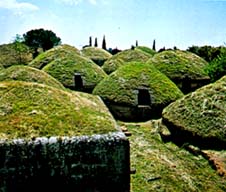
|
|
| Tarquinia tumulus tombs |
| The tumulus mounds that form the outer shell of the Tarquinia tombs |
| |
|
| |
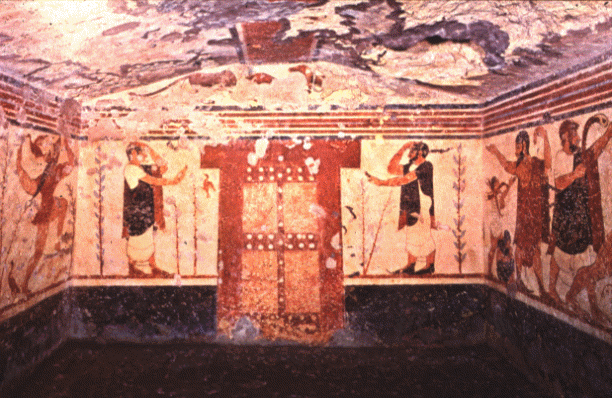
|
|
| Augurs tomb |
| Frescoes from the Augurs tomb depicting funerary games |
| |
|
| |
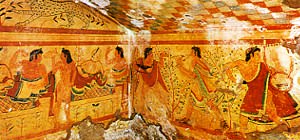
|
|
| Tarquinia art |
| Art from a Tarquinia tomb |
| |
|
| |
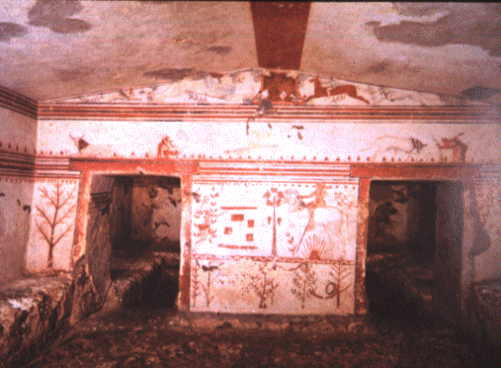
|
|
| Tomb of the Bulls |
| Wall frescoes from the Tomb of the Bulls |
| |
|
| |
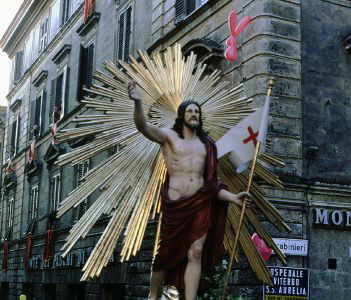
|
|
| Tarquinia Parade |
| A statue of Jesus from a parade |
| |
|
The tombs at Tarquinia are the most interesting aspect of this site. They feature frescoes, wall and ceiling paintings, and undergound tombs that appear as small grassy mounds from the surface. There are thousands of tombs, and they somewhat resemble the Shire.
Much interest has been directed at the depictions in the many frescoes that decorate the tombs. Some display games and sporting contests, while others show people involved in traditional ceremonies.
There is a museum in the Vitelleschi palace which was built in the 15th century and open to the public. The musuem features many Greek and Etruscan ceramic works. Wall paintings stripped from the tombs are also on display here.
There are five churches nearby, which exhibit works of Etruscan, Roman, and Gothic art. These are the Church of S.Maria in Castello, Church of S.Maria di Valverde, a cathedral built in the 15th century, Church of Annunziata, and the Church of S.Francesco.
Neighborhood and food festivals are common in the autumn months, while visitors in town on August 15th can enjoy the Ascension Day parade.
The modern Tarquinia, located near the original Etruscan site, has kept its mediavel architecture and the Basilica is a well-known landmark.
|
| |
|
| |
|
| |
Analyze Image |
| |
| |
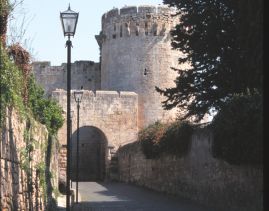
|
|
| Tarquinia Corneto |
| The modern day architecture of Tarquinia Corneto, the city |
| |
|
This image shows the beauty and medival roots of Tarquinia. While the tranquility of the picture depicts the Tarquinia which exists today, it does not show the history of the Etruscan city from which it sprang. While Tarquinia is located a few miles from the tombs, the art and tombs are famous attractions that are excluded from this picture. The site itself is difficult, if not impossible, to capture in one picture. The ancient Tarquinia which is best illustrated by the extensive tombs contrasts with the city which now rests upon a nearby hill. However, both the city and tombs attribute their ancient history to the same Etruscan civilization, which is evident from the presence of Etruscan culture in modern and ancient Tarquinia.
|
| |
|
| |
|
| |
Site Questions |
| |
How much of the Etruscan culture is reflected in the modern city?
The tombs were uncovered but now appear as mounds in the ground. Who unearthed and explored most of the tombs and when?
Why did a city of strategic location decline later in its history?
|
| |
|
| |
|
|
 |
|
